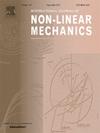Research on dynamic characteristics of electromagnetic SD oscillator system under state feedback control
IF 3.2
3区 工程技术
Q2 MECHANICS
International Journal of Non-Linear Mechanics
Pub Date : 2025-05-04
DOI:10.1016/j.ijnonlinmec.2025.105103
引用次数: 0
Abstract
To enhance the robustness of the smooth and discontinuous (SD) oscillator system, an electromagnet incorporating displacement-velocity state feedback control is integrated above the oscillator. The electromagnetic interaction between the electromagnet and the oscillator facilitates accelerated system stabilization. This study investigates a novel electromagnetic SD oscillator. Initially, the steady-state amplitude-frequency and phase-frequency response characteristics are derived using the averaging method, with an analysis of how each state feedback parameter influences the amplitude-frequency curve. Utilizing Lyapunov stability theory and the Routh criterion, the stability conditions for the system's periodic solutions are established. Subsequently, the Melnikov theorem is employed to determine the necessary conditions for the onset of chaos within the system. Dynamic bifurcation analysis, maximum Lyapunov exponent (LLE) curves, and system behaviors under various parameters are examined to assess the impact of state feedback parameters on the chaotic boundary curve. On this basis, the global bifurcation characteristics of different parameters of the system are studied by using the cell mapping method, and the influence of each parameter on the number of attractors and the domain of attraction is analyzed. Finally, the displacement transmissibility is used to evaluate the vibration isolation effect of the system. The findings indicate that the electromagnetic SD oscillator exhibits superior vibration reduction capabilities, effectively mitigating chaos and bifurcation phenomena. Optimal selection of state feedback parameters enables rapid system stabilization under external excitation conditions.
状态反馈控制下电磁SD振荡器系统动态特性研究
为了提高光滑不连续振荡器系统的鲁棒性,在振荡器上集成了一个位移-速度状态反馈控制的电磁铁。电磁铁和振荡器之间的电磁相互作用促进了系统的加速稳定。本文研究了一种新型电磁SD振荡器。首先,采用平均法推导稳态幅频和相频响应特性,分析各状态反馈参数对幅频曲线的影响。利用Lyapunov稳定性理论和Routh判据,建立了系统周期解的稳定性条件。随后,利用Melnikov定理确定了系统内部混沌发生的必要条件。通过动态分岔分析、最大Lyapunov指数(LLE)曲线和系统在不同参数下的行为来评估状态反馈参数对混沌边界曲线的影响。在此基础上,利用单元映射方法研究了系统不同参数的全局分岔特征,并分析了各参数对吸引子数和吸引域的影响。最后,利用位移传递率对系统的隔振效果进行了评价。研究结果表明,电磁SD振荡器具有良好的减振能力,能有效缓解混沌和分岔现象。状态反馈参数的最优选择使系统在外部激励条件下快速稳定。
本文章由计算机程序翻译,如有差异,请以英文原文为准。
求助全文
约1分钟内获得全文
求助全文
来源期刊
CiteScore
5.50
自引率
9.40%
发文量
192
审稿时长
67 days
期刊介绍:
The International Journal of Non-Linear Mechanics provides a specific medium for dissemination of high-quality research results in the various areas of theoretical, applied, and experimental mechanics of solids, fluids, structures, and systems where the phenomena are inherently non-linear.
The journal brings together original results in non-linear problems in elasticity, plasticity, dynamics, vibrations, wave-propagation, rheology, fluid-structure interaction systems, stability, biomechanics, micro- and nano-structures, materials, metamaterials, and in other diverse areas.
Papers may be analytical, computational or experimental in nature. Treatments of non-linear differential equations wherein solutions and properties of solutions are emphasized but physical aspects are not adequately relevant, will not be considered for possible publication. Both deterministic and stochastic approaches are fostered. Contributions pertaining to both established and emerging fields are encouraged.

 求助内容:
求助内容: 应助结果提醒方式:
应助结果提醒方式:


